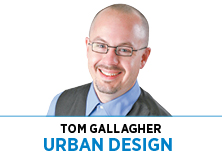Subscriber Benefit
As a subscriber you can listen to articles at work, in the car, or while you work out. Subscribe Now On a recent weekend trip downtown, I was happy to find so many people out and about. Life on the street, though certainly not at pre-pandemic levels, is reemerging. While doing the simple things—maintaining your distance, washing your hands, and wearing a mask—remains key, it is encouraging to see in action the creativity and ingenuity helping to bring us safely back together.
On a recent weekend trip downtown, I was happy to find so many people out and about. Life on the street, though certainly not at pre-pandemic levels, is reemerging. While doing the simple things—maintaining your distance, washing your hands, and wearing a mask—remains key, it is encouraging to see in action the creativity and ingenuity helping to bring us safely back together.
Unfortunately for me, all the activity also meant I missed out on the opportunity that drew me downtown that day, spending some up-close time with the temporary storefront murals that adorned buildings boarded up during the recent protests. Having seen some of the works through a windshield or pictures in the media, I wanted to see more. Intentionally temporary, most have now been removed as businesses reopen.
These murals represent Indy at its best. Business owners and advocacy organizations, like St’artup 317 and the Arts Council of Indianapolis, rapidly responded to peril with positivity, using their “Listening Through Art” initiative to create an opportunity for Black artists to extend the message and meaning behind the protests on a temporary “community canvas.”
It should come as no surprise that it has been artists, in our city and across the country, who have been taking center stage, helping the rest of us make sense of the difficult times we are experiencing. Far too often thought of as only a luxury, art has played an intimate role in defining who we are, individually and collectively, throughout history. If science is the search for truth through the lens of the physical and numerical, art is a view of that truth through emotion and meaning.
The fact that the recent protests are still necessary might stand as proof enough that we need more art in our lives. Anger, fear and guilt are natural emotions we all grapple with. They are messages to be heard and explored. They become liabilities only when, without other outlet or understanding, they incite actions of hate and divisiveness.
Commensurate with that calling, artists of all kinds will be an essential part of the city’s recovery. As important as beauty and levity are, artists bring an even more profound set of sensibilities to the discussion.
◗ They see opportunity where others see void.
The challenges facing our city can seem overwhelming and insurmountable. Nevertheless, whether in moments of need, like the downtown storefront murals, or at longer-term outposts like the Tube Factory, the Murphy Arts Center, and their precursors, artists are regularly the pioneers willing to fill the perceived emptiness with a sense of community.
◗ They infuse places with a sense of identity.
With so much standardization in our cities due to cars, mechanical systems, and building and development codes, it can feel like we are all living in the same homogenous place. Art, whether it’s as simple as an Instagrammable moment or as formal as the symbol of our city at the center of Monument Circle, creates distinctions between places that, as the Knight Foundation’s Soul of the Community Study points out, builds the social capital so necessary for vibrant and resilient cities.
◗ They keep us mindful of a higher purpose.
Maintaining the vitality of a city is like training a finely tuned athlete. We must break down muscle to build it back. With effort, time and discipline, the discomfort gives way to strength and stamina. It is difficult to stay vigilant to the things that matter, however, and fitness fades quickly. On stage or on a canvas, artists’ works, at their best, are mirrors, poignant reminders of who we really are and what we could be. Art cajoles, provokes, demands and inspires us to be better than the day before.
I look forward to seeing the murals again. The sponsors of Listening Through Art hope to store them as they are removed from repaired businesses and bring them back for public viewing along the Cultural Trail and in other public spaces downtown. Even more so, I look forward to seeing what our arts community has in store for our future.•
__________
Gallagher is a principal and urban designer with Ratio and a professor-in-practice of urban design at Ball State University. Send correspondence to [email protected].
Please enable JavaScript to view this content.

